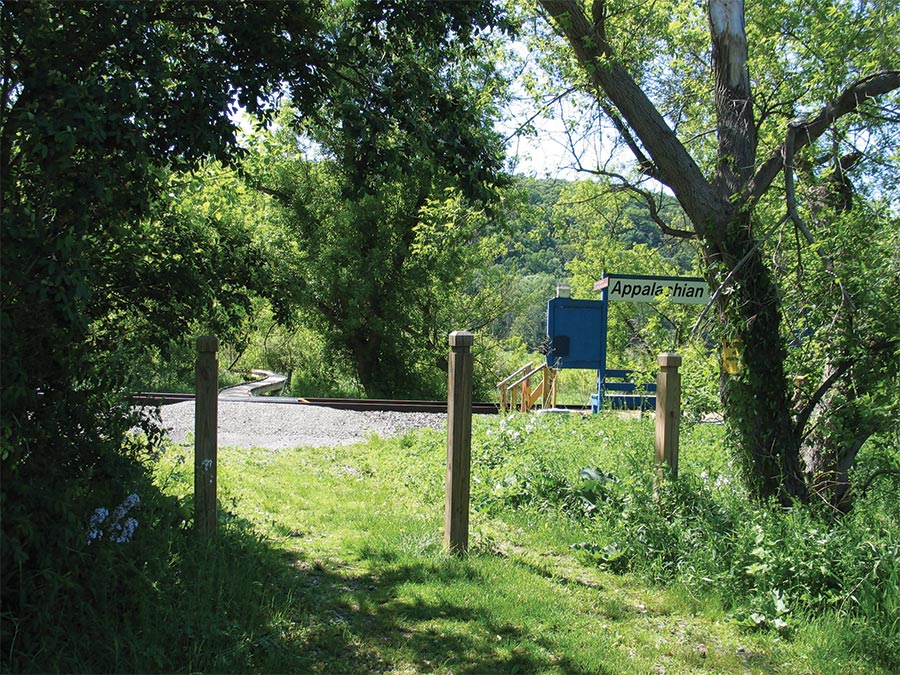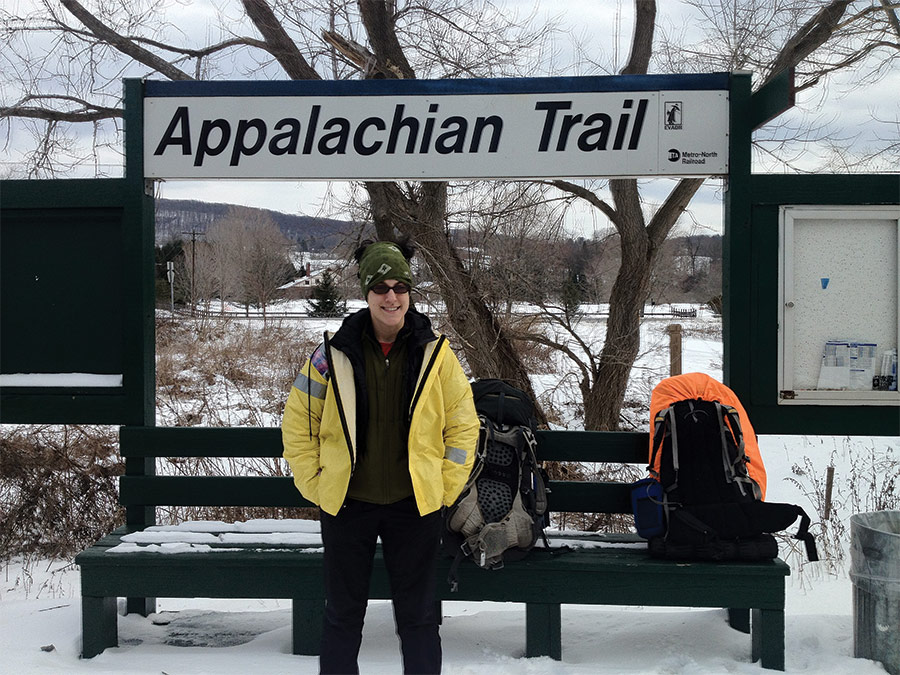
By Lynn Davis
GEO.TOUR.ISM
Is best described as sustaining or enhancing “the geographical character of a place — its environment, culture, aesthetics, heritage, and the well-being of its residents.”
The Towns of Dover and Pawling, New York, know they have a good thing going: travel and tourism thrive. But now the towns are taking things to the next level, working in collaboration with partners in and around the Harlem Valley — in partnership with the Appalachian Trail Conservancy (ATC) — to design and build a dynamic new “geotourism” initiative.
View from the A.T. over the Harlem Valley ![]() Photo by Julian Diamond
Photo by Julian Diamond
View from the A.T. over the Harlem Valley ![]() Photo by Julian Diamond
Photo by Julian Diamond
The Towns of Dover and Pawling, New York, know they have a good thing going: travel and tourism thrive. But now the towns are taking things to the next level, working in collaboration with partners in and around the Harlem Valley — in partnership with the Appalachian Trail Conservancy (ATC) — to design and build a dynamic new “geotourism” initiative.
Already, thousands of visitors make their way from the urban pace of New York City and Philadelphia to the serenity of the bucolic countryside, the wooded foothills of the Berkshires, and the horse farms in the Hudson Valley. On weekends and holidays, Metro-North Railroad’s Harlem Line transports New York City residents directly to the Appalachian Trail in just over two hours. It is the only rail stop located directly on the Trail, and the “station” — as local community leaders call it — is complete with posted hiking information for visitors. The area promotes a mix of outdoor recreation, arts, and culture.
In Pawling, visitors connect with guides at the Anglers Den to fly fish the “Ten Mile River” and gear up at Pawling Cycle and Sport to ride the backcountry roads of the Harlem Valley. Or enjoy a farm-to-table menu at McKinney and Doyle after scouting the local book store and art galleries. In Dover Plains, travelers walk along a maple-shaded path to the “Dover Stone church,” a cavern with angular shapes like cathedral windows carved by a 30-foot waterfall, spend hours at the beloved Lucky Orphans Horse Rescue, and drop by the fifth-generation Brookby Farm and Dairy for raw milk and fresh cheese. In Millerton, hikers and cyclists enjoy a restored rail trail — and visitors cozy up at the Harney & Sons tea room to sample exotic blends. After a long day, the intensity of stars wows night sky lovers.
“Dover and Pawling, and their sister townships have grown in popularity and have been sustained by tourists — by people searching for something different from city life,” says Stancy DuHamel, an ardent advocate for the area. “But that’s not enough — not for the long-term. It’s not enough to attract travelers to the area to build and bolster tourism revenues,” continues DuHamel. “We want to make certain that we’re not giving up our soul to appeal to visitors, and that we’re giving people who travel to Harlem Valley opportunities to connect with our special places.”
Ecotourism & Geotourism
Ecotourism is often defined as low-impact travel to relatively undisturbed natural areas with a focus on natural resources, conservation, and sustainability. Geotourism is best described as sustaining or enhancing “the geographical character of a place — its environment, culture, aesthetics, heritage, and the well-being of its residents.” Both are nuanced descriptions, according to James Dion. Geotourism embraces all the principles and adds a driving element — maintaining the integrity of a community. “It’s not about changing the place to meet the interests of developers and outside visitors,” says Dion. “It is how to optimally and authentically represent our community.”
Dion has worked on geotourism initiatives around the world as an executive of the National Geographic Society. In the U.S., Dion launched more than two-dozen geotourism campaigns including the well-established Crown of the Continent initiative along the U.S. and Canadian border near Glacier National Park, which many consider a premier model for linking conservation and community development. In the Greater Yellowstone region, another western geotourism example Dion points to, is how Driggs, Idaho distinguished itself from Jackson Hole, Wyoming. Both towns are in the shadow of the Grand Tetons — Jackson Hole is east of the Teton range and Driggs is on the western slopes.
Driggs, which now claims the first-ever geotourism visitor center, assessed the town’s assets and juxtaposed its old-time drug store and soda fountain with new health food stores and outdoor gear shops, developed seasonal travel itineraries, and examined how visitors interact with the town. “They didn’t try to create Jackson Hole-like amenities. They did what was true to them and now they’re reaping great benefits,” Dion says. Dion endorses the ATC’s commitment to enhance community identities and build stewardship. “The Appalachian Trail is a perfect place for geotourism,” Dion says. “Each community has a unique character that offers all sorts of identity-building possibilities. And the Trail, collectively, is important as a natural and cultural resource.”
A.T. Communities & Geotourism
Last June, the ATC announced four ground-breaking geotourism pilot programs, beginning in 2018 and extending through 2019. In addition to selecting the Pawling and Dover area in New York, the other selected areas include communities near Delaware Water Gap in New Jersey and Pennsylvania, and Harpers Ferry and Bolivar, West Virginia. The geotourism initiative supports a successful ATC Community program.
“ … Speaking up on behalf of open space is important now and will be increasingly essential to preserving the Appalachian Trail.”
In 2010, the ATC established its first official A.T. Community with the over-arching goal of building partnerships with Trail towns. Partnerships raise awareness of the Trail as an asset to residents, support planning and initiatives for growing outdoor recreation economies, and build connections and dialogue with land managers and community leaders. To date, 47 communities have completed an application process and rigorous review. Designation requires the creation of an advisory committee, A.T.-related events, and volunteer projects; and a commitment to consider the Trail in community land-use plans, ordinances, and guidelines.
“In 2006, we started a pilot program in two communities to gauge interest and needs and discovered that each community has unique opportunities and challenges,” says the ATC’s director of education and outreach Julie Judkins. “The application and designation process allows communities to build a diverse group of leaders to assess possibilities, needs, and establish a dialogue with Trail management partners.” Many A.T. Communities identify a need to increase hiker services and awareness of access to trailheads and recreation. This year, the ATC organized three regional summits for A.T. Community representatives to share their successes in attracting visitors to their respective Trail towns and their impact on building awareness and stewardship regarding the Trail and other nearby natural resources.
“Trail towns, whether they are big or small, are key to the sustainable future of the Appalachian Trail,” says the ATC’s president and CEO Suzanne Dixon. The ATC’s ramped-up community initiative coincides with increasing attention on the economic importance of the outdoor industry economy. Outdoor recreation generates $887 billion in consumer spending each year and 7.6. million jobs throughout the United States, according to a recent report released by the Outdoor Industry Association.


On weekends and holidays, Metro-North Railroad’s Harlem Line transports New York City residents directly to the Appalachian Trail and is the only rail stop located directly on the Trail.
Two years ago, Congress unanimously passed the bipartisan “Outdoor REC Act,” which recognizes the outdoor recreation economy as part of the U.S. Gross Domestic Product, directing the Department of Commerce to assess and certify the outdoor industry’s contributions to the national economy.
Dixon frequently refers to the “win-win” of working with Trail Communities and says that the added geotourism initiative is an important tool for community-driven engagement. She anticipates that each pilot community will address what works and what can be improved. “We expect new concepts and new ways of getting the ‘locals’ excited about hospitality,” she says.
Each pilot program examines how the Appalachian Trail and the town relate to each other, and outlines prevalent perceptions, both positive and negative. Already, research has documented low awareness of recreational options among visitors and local residents alike. Research also has uncovered gaps in visitor and transportation services and skepticism in the Trail town’s overall potential. “We anticipate that baseline data will provide a roadmap for improvement and a gauge of success,” says Dixon. She adds that there are additional benefits. “Nationwide, retirees and entrepreneurs are relocating near national parks, national forests, and wildlife refuges. People move to the places where their backyard is federally protected. And people stay in places where they feel connected. When communities recognize the value of public lands in their backyards, they are building the foundation of stewardship,” Dixon says. “The A.T. is increasingly in need of advocates and strong stewards, particularly as the population in the eastern United States grows. Speaking up on behalf of open space is important now and will be increasingly essential to preserving the Appalachian Trail.”